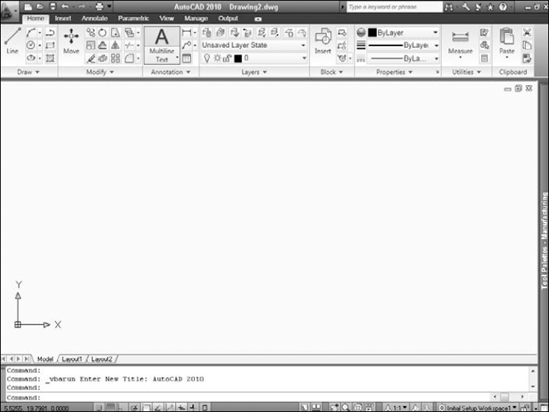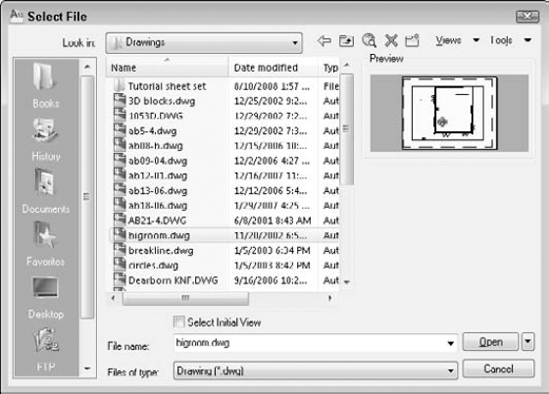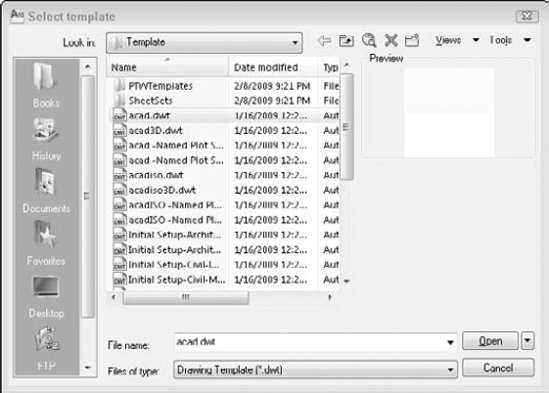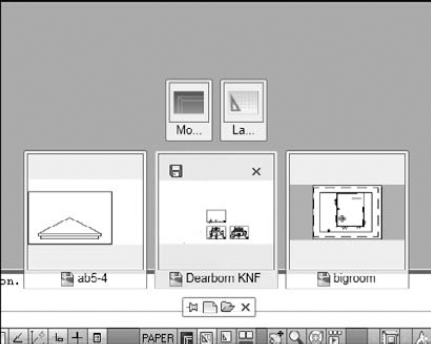AutoCAD and AutoCAD LT offer a number of options for opening new and existing drawings. These options create a great deal of flexibility and save you time as well. You can create complex templates to avoid doing the same basic setup and drawing over and over.
A template is a special file that contains drawing settings and often objects (such as a titleblock and text). A template has a DWT filename extension. When you use a template as the basis for a new drawing, the drawing takes on all the settings and objects contained in the template. Use templates to avoid re-creating settings and redrawing objects for new drawings. AutoCAD and AutoCAD LT come with many templates that you can use as is or customize. You can also create your own templates.
Note
When you launch AutoCAD or AutoCAD LT for the first time, the Initial Setup window opens, prompting you to specify certain settings about your drawing environment. Those settings will affect the default template. For more information, see Appendix A.
To create a new drawing based on a template, choose Application Button
Choose Application Button, click the Options button, and click the Files tab.
Double-click the Template Settings item.
Double-click the Default Template File Name for QNEW item.
Click the listing under the Default Template File Name for QNEW item (which says None by default).
Click Browse to choose the template that you want.
Click OK to close the Options dialog box.
You can specify whether this default template uses metric or imperial measurements by setting the MEASUREINIT system variable. (System variables are discussed further in Chapter 5.) On the command line, type measureinit
The default template is acad.dwt for AutoCAD and acadlt.dwt for AutoCAD LT. Another default template is acad -Named Plot Styles.dwt or acadlt -Named Plot Styles.dwt, which refers to named plot styles. (See Chapter 17.)
STEPS: Opening a Drawing Based on the Default Template
Start AutoCAD or AutoCAD LT.
Choose Application Button

From the Select Template dialog box, choose
acad.dwt(for AutoCAD) oracadlt.dwt(for AutoCAD LT) from the list.Click Open. You now have a blank drawing named
Drawing2.dwg, as shown in Figure 2.2.

Figure 2.2. When you create a drawing based on a template, AutoCAD or AutoCAD LT creates a new drawing.
Note
The default workspace is 2D Drafting & Annotation. However, you can choose another 2D workspace, AutoCAD Classic (for AutoCAD) or AutoCAD LT Classic (for AutoCAD LT), from the Workspace Switching button on the right side of the status bar. For 2D drawing in AutoCAD only, make sure that you're not in the 3D Modeling workspace. I discuss workspaces in Appendix A.
In both AutoCAD and AutoCAD LT, you may see palettes (windows) open that you don't want to use right now. You can close these by clicking their Close (X) buttons.
A template contains ready-made settings to get you started drawing quickly. These settings include the size of the drawing (called limits), the unit type (such as decimal or feet and inches), and others. An important part of setting standards in an office where people work together on drawings is the creation of a template so that all users work with an identical setup. Templates may contain more than just settings — they often contain a complete titleblock, for example, and may include boilerplate (standardized) text as well.
Note
In Chapter 5, I explain the options available for setting up a drawing. In Chapter 26, I cover the process of setting standards for drawings.
Most people customize the default template to create one or more templates that suit their particular needs. After your templates are created, you don't have to worry about most settings; they are already available for you, and you can quickly start to draw.
To customize acad.dwt or acadlt.dwt, follow these steps:
Create a drawing based on a template as described in the previous section.
Make any changes you want.
Click Save on the Quick Access toolbar.
In the Save Drawing As dialog box, click the Files of Type drop-down list box. Choose AutoCAD Drawing Template or AutoCAD LT Drawing Template (
*.dwt). In the list of template files, choose the template that you want to customize. Click Save.When asked if you want to replace it, click Yes.
From the Measurement drop-down list, choose English (Imperial) or Metric, depending on the type of units you plan to use.
In the Template Options dialog box, revise the description as you like. (For information about the New Layer Notification option, see Chapter 26.)
Click OK.
Warning
If you're using someone else's computer, don't change the templates that come with AutoCAD or AutoCAD LT without first checking with the computer's owner. Also, if you create new templates, put them in their own folder to avoid losing them when you upgrade or reinstall AutoCAD.
You may want several templates to choose from on a regular basis. For example, you may create drawings of several sizes. AutoCAD and AutoCAD LT let you create as many templates as you want. To create your own templates, either start a drawing based on a template and make the changes you want, or open an existing drawing that already has some of the settings you want and make any further changes you need. Follow these steps:
If you start a new drawing based on a template, choose Save from the Quick Access toolbar. If you open an existing drawing, choose Application Button

Make any changes you want.
In the Save Drawing As dialog box, click the Files of Type drop-down list. Choose AutoCAD Drawing Template or AutoCAD LT Drawing Template.
In the File Name text box, type a name for your template. Click Save.
In the Template Options dialog box, enter the description as you want. From the Measurement drop-down list, choose English (Imperial) or Metric, depending on the type of units you plan to use. (I discuss the New Layer Notification option Chapter 26.) Click OK.
Tip
Name your templates in a way that clearly differentiates them from regular drawings. You may want drawings set up for each of the standard paper sizes (A through E), with a titleblock in each. Useful names might be tb-a.dwt, tb-b.dwt (tb meaning titleblock), and so on.
Most AutoCAD and AutoCAD LT users take advantage of these techniques as a standard practice. You can usually make profitable use of a template as the basis for a new drawing.
Occasionally, you may want to create a drawing without any settings. It is actually impossible for a drawing to have no settings at all, but you can create a drawing with the minimum possible presets. You might want to do this if you're working on someone else's computer and don't want to take the time to get rid of a large number of complex settings that aren't helpful for your work.
To create a drawing with the fewest possible settings, choose Application Button
Open with No Template — Imperial
Open with No Template — Metric
Often you need to open an existing drawing, either to complete it or to make changes. Opening a drawing in AutoCAD or AutoCAD LT is like opening a file in any Windows program. You can find existing drawings by name or by viewing a thumbnail (preview image) of the drawing.

Figure 2.3. The Select File dialog box is equivalent to the Open dialog box in most Windows programs.
If you have opened the drawing recently, click the Application Button and look at the Recent Documents list on the right. At the top of the file list, click the arrow button to choose By Ordered List (alphabetical — the default), By Access Date, By Size, or By Type (file type). To the right is a small drop-down list that you can click to view icons or small, medium, or large images of the files. When you hover the cursor over any drawing, a tooltip displays, showing you a preview of the drawing, the full path location, the last date it was modified, the release version, the last person who saved the drawing, and who has the drawing currently open, if anyone. Finally, you can click the Pin icon next to a drawing to stick it to the list; the file remains there until you "unpin" it. All these features can help you easily find the drawing you want.
Tip
You can change the number of drawings that appear on the list. Choose Application Button
You can double-click a drawing in Windows Explorer to open it. If AutoCAD or AutoCAD LT is not running, Windows loads the program and the drawing as well. If AutoCAD or AutoCAD LT is running and a drawing is active, the drawing opens as a second drawing within the program.
You can open a drawing using the Sheet Set Manager (AutoCAD only). I cover sheet sets in Chapter 26.
When you open more than one drawing, by default, AutoCAD and AutoCAD LT display only one button on the Windows task bar. If you want to display a separate task bar button for each drawing, type taskbar
If you're using the default task bar setting, switch from drawing to drawing in one of the following ways:
Note
The drawing used in the following exercise on opening a drawing, abqs-01.dwg, is in the Results folder of the AutoCAD 2010 and AutoCAD LT 2010 Bible DVD.
STEPS: Opening a Drawing
If AutoCAD or AutoCAD LT is not open, start the program.

In the Select File dialog box, choose the drive for your DVD in the Look In drop-down list.
In the main box, double-click the
Resultsfolder.In the main box, click
abqs-01.dwg.Click Open. The drawing opens.
Click the Close (X) button in the upper-right corner of the drawing window to close the drawing.
Whether you want to use an existing drawing as a prototype or simply make a copy of a drawing, you need to save the drawing under a new name. First open the drawing and then choose Application Button
In the Save Drawing As dialog box, type a new name in the File Name text box. Then click Save. You may also want to change the location of the new drawing by changing the folder in the Save In drop-down list box.
In this chapter, you explored the various ways of opening a drawing. You learned the following:
Starting a new drawing based on a template
Customizing a template
Creating your own templates
Starting a new drawing with no template
Opening an existing drawing and switching among open drawings
Saving a drawing under a new name
In the next chapter, you read about using commands.


